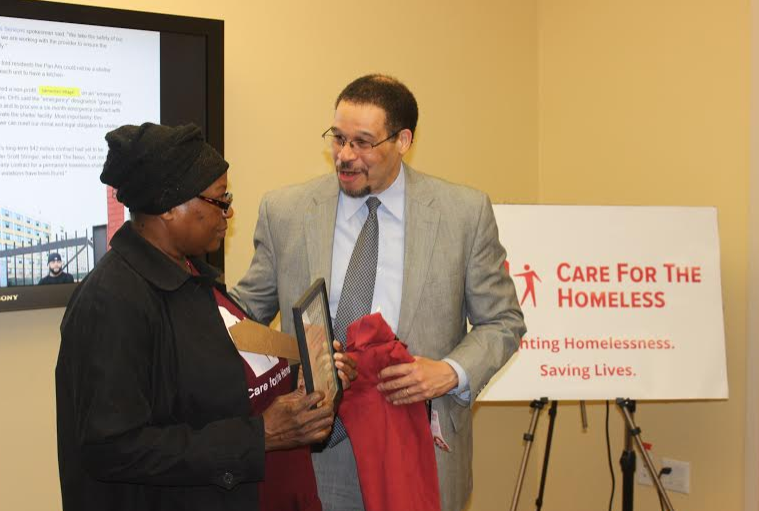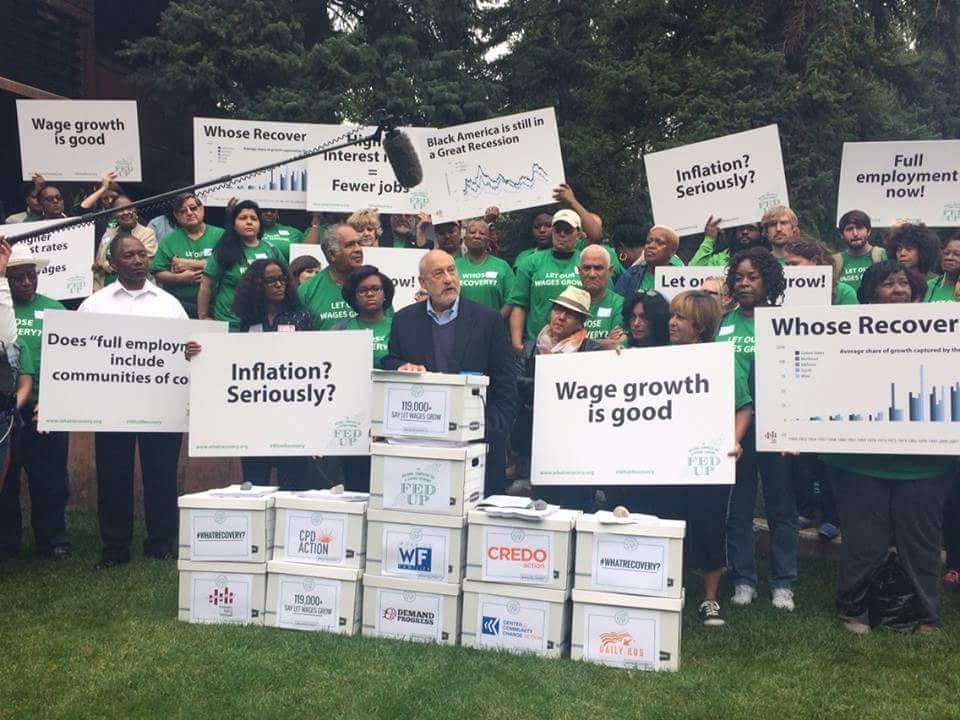Fed Mistake Will Hurt New York Working Families
The Federal Reserve (Fed) just made a huge mistake. Because the Fed raised interest rates lat week, Americans will see higher mortgages, more expensive loans, fewer jobs, and lower wages for working people like me. The Fed’s leaders say they want to “cool down” the economy because they think that we’ve recovered from the financial crash, but for New Yorkers like me, there just hasn’t been a recovery that justifies this rate change.
I immigrated to the United States from Ecuador four years ago to build a better life. But instead of finding economic opportunity, I have had to work two jobs, 60 hours a week, just to afford a room in an apartment with three other roommates. My jobs as an administrative assistant and in customer service each pay only $8.75 an hour.
The idea that the economy is doing well enough right now is a lie. I don’t have time for my family, I don’t have time for my relationships, and I still barely survive. And I know there are millions more like me--in New York and beyond--suffering the same fate. Those at the Fed who say the economy is fine are treating us as invisible. They are choosing to not see our struggles.
I can only imagine what it would be like to work 40 hours at a livable wage. I wouldn’t have to worry about the bills I can’t afford. I would have time for my mother and for my partner. I could even study for another career.
Because the Fed is raising interest rates, the economy will slow down, and employment and wages will likely freeze or start to fall again. When Fed leaders decided to raise interest rates, they told us to get used to the economy as it is: twice as many people as before the recession working part-time because they can’t find full-time work, double-digit unemployment in communities of color, and decades of flat wages. The Fed is undercutting an economic trend that would help us before giving us a chance to get back on our feet.
The Fed has two mandates: to maximize employment and to maintain stable prices. The main reason to raise interest rates would be to stop inflation. But there is virtually no inflation in the economy – we are far below the Fed’s target rate. The Fed decided to sacrifice all the jobs that we could have gotten and all the wage gains we could have won with low interest rates, all for the sake of an inflation threat that didn’t even exist. Furthermore, most of those unnecessary sacrifices of jobs and wages will be losses borne by Latino and black communities.
Working New Yorkers need a recovery that works for everyone, including communities of color. We all have dreams. Dreams of a better job, more time to be with our families, and to have a better home. When the Fed raised rates, it said that my struggles and the dreams of my community do not matter.
Millions of Americans haven’t yet felt the recovery. Don’t try to tell us that the economy is working just fine.
***
Aracelly Cantos is a Queens resident and member of Make the Road New York, the largest grassroots community organization in New York offering services and organizing the immigrant community, and a member of the Fed Up campaign. On Twitter: @maketheroadny.
Observing Homeless Persons' Memorial Day

Bobby Watts, the author, right (photo via Care for the Homeless)
Many New Yorkers have become aware of the cost of homelessness on our social fabric and on municipal budgets. One of the greatest costs is often overlooked: homelessness is hazardous to one's health and leads to premature death. Tonight, December 21st, the winter solstice, is the longest night of the year, and the day Homeless Memorial Day is observed in over 175 communities in America including New York City. It's a day to remember our neighbors who died while experiencing homelessness and to recognize the extraordinary toll homelessness takes on the health and longevity of people and also on the public health of our community and nation.
The most basic measure of health is mortality – whether someone lives or dies. According to the federal Centers for Disease Control and Prevention (CDC), the average lifespan for a New Yorker is over 80 years. For those experiencing chronic homelessness, it is not surprising that their life expectancy is shorter – but the amount it is shortened is shocking.
Overall, the age-adjusted mortality rate of homeless people is three to four times higher than their peers living in homes, and much higher for some age groups. Studies consistently document the average age of those experiencing chronic homelessness who die while living on the streets to be in their forties or fifties, which represents an incredible loss of 30 to 40 years of life. Epidemiological studies have determined homelessness is in and of itself a cause of these premature deaths, even after controlling for factors such as mental illness, substance use, and chronic and acute illnesses. Simply put, homelessness kills.
Let me say it again: homelessness kills.
For the millions of Americans suffering homelessness and unstable housing, and the 58,000 people sleeping in homeless shelters in New York City this long night, the lack of housing may be a premature death sentence.
As a public health professional, and director of a health care program serving homeless people, I've often heard physicians and clinicians longing to be able to write the prescriptions that would most improve their patients' conditions - a script for housing. Unfortunately, health care practitioners don't have the ability to write that prescription. But society does.
Governor Cuomo and the New York State Department of Health have adopted a "Housing is Health Care" public policy by using state Medicaid funds to house chronically homeless or marginally-housed patients. These policies deliver better health outcomes for homeless people, improve communities and promise tax savings through fewer emergency room visits, hospitalizations, and re-admissions, and through shorter hospital stays.
We understand how to end modern-day homelessness because we've seen programs that work. We know providing adequate medical and mental health services as well as needed human services to people experiencing homelessness yields dramatic dividends in better health and housing outcomes and pays for itself. This year, New York City increased funding to prevent homelessness by 50 percent after having previously doubled it, and we've had some success – we just need more investment in these proven programs. For example, we join with advocates that call on the Cuomo administration to join Mayor de Blasio's and contribute to the construction of the 35,000 units of supportive housing needed to meet demand.
I hope everyone reading this column will take part in a Homeless Memorial Day observance too, or at least pause to think about the avoidable deaths, suffering, and despair that we could prevent through better public policies. My not-so-silent prayer today will be to end homelessness and negate the need for many more Homeless Persons' Memorial Days.
***
Bobby Watts is Executive Director of Care for the Homeless, one of New York City's oldest and largest providers of health care and other services to people experiencing homelessness, and past President of the National Health Care for the Homeless Council. On Twitter @CFHNYC.
***
Have an op-ed idea or submission for Gotham Gazette? E-mail editor Ben Max: This email address is being protected from spambots. You need JavaScript enabled to view it.
New York Leads on Climate Action

(photo via @WhiteHouse)
World leaders voted this past weekend on a final agreement to limit global warming to no more than 1.5 degrees Celsius, a benchmark scientists say is critical to avoid devastating impacts that could render the planet uninhabitable. Despite what the fossil fuel industry and their allies in Congress would have world leaders believe, New Yorkers and Americans across the country are excited about this bold agreement coming out of the U.N. conference on climate change.
For one thing, too many of us already know first-hand the damage done by extreme weather fueled by global warming. In fact, a recent map showed that 100 percent of the state's population lives in counties hit by at least one weather-related disaster in the last five years. Hurricane Sandy, which left two million people without access to power and a total of $19 billion in damage, is just one example.
No one wants to leave the next generation a world where devastating floods become the new normal. And that's helped prompt a diverse group of New York leaders to stand behind the largest step the United States has ever taken to slow global warming.
The Clean Power Plan sets the first-ever federal limits on carbon pollution from power plants, the single largest source of U.S. greenhouse gas emissions, and incentivizes states to develop plans to replace dirty fossil fuels with clean renewable energy sources.
Local elected officials are charged with protecting us against the impacts of climate change and are already leading the way with their own clean energy solutions. That's why 600 of them across the country wrote to President Obama to act on climate and pledged their support, including New York City Public Advocate Letitia James and New York State Senator Brad Hoylman.
So, too, do nearly 1000 public health professionals from across the country and approximately 70 here in state, who agree with the leading medical journal, The Lancet, that climate change represents "the biggest global health threat of the 21st century" because it threatens more drought, heat waves, insect-borne disease, and dwindling drinking water supplies.
Clean energy businesses - including over 40 here in New York – stand ready to play a leading role in implementing the carbon pollution limits as we have vast untapped potential for both solar and wind power.
More than 300,000 comments from New Yorkers were among the eight million submitted across the country in favor of the carbon pollution limits, while polls show that 76 percent of New Yorkers -- spanning party lines -- supports the Clean Power Plan.
And it's not just the Clean Power Plan that the public and opinion leaders are rallying behind; it's a full suite of actions to stem the climate crisis.
A New York Times/CBS poll conducted in late November shows that two-thirds of Americans support the United States joining a binding international agreement to curb the growth of greenhouse gas emissions. More than 60 mayors back "the strongest possible agreement" in Paris to cut pollution, while more than 100 have committed to tracking and reducing their own contribution to the problem. Right here in New York City, Mayor Bill de Blasio is a founding member of a group of local leaders who have said they would work to reduce carbon emissions by 80 percent by 2050. And earlier this month, Governor Andrew Cuomo directed the State Department of Public Service to design and enact a new Clean Energy Standard mandating that 50 percent of all electricity consumed in New York by 2030 result from clean and renewable energy sources.
Congressional leaders adopted symbolic measures in recent weeks to dismantle the Clean Power Plan in order to give diplomats in Paris the impression that the U.S. isn't behind bold climate action. But the only message they sent was that they alone are determined to stand with polluters and on the wrong side of history.
***
Heather Leibowitz, Esq. is the director of Environment New York, a statewide environmental advocacy organization. On Twitter @EnvNY.





